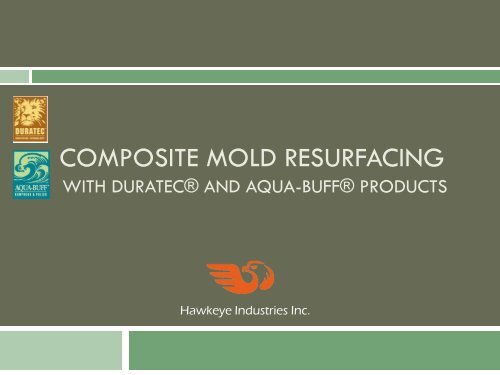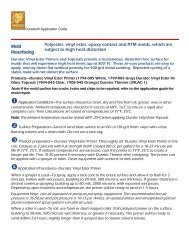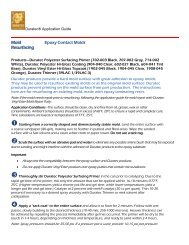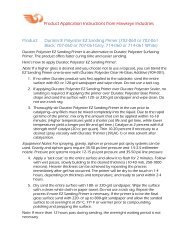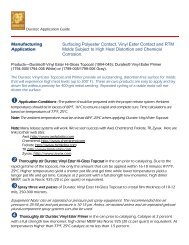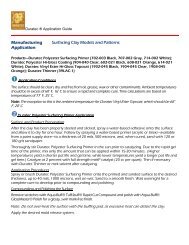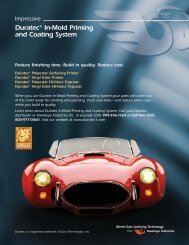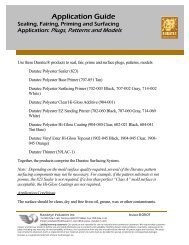Composite mold resurfacing - Hawkeye Industries
Composite mold resurfacing - Hawkeye Industries
Composite mold resurfacing - Hawkeye Industries
You also want an ePaper? Increase the reach of your titles
YUMPU automatically turns print PDFs into web optimized ePapers that Google loves.
COMPOSITE MOLD RESURFACINGWITH DURATEC® AND AQUA-BUFF® PRODUCTS<strong>Hawkeye</strong> <strong>Industries</strong> Inc.
When to resurface? A businessdecision. High quality <strong>mold</strong>s produce high quality parts andresult in less rework. Mold <strong>resurfacing</strong> is a realistic option to <strong>mold</strong>replacement when the <strong>mold</strong> is structurally sound andonly the gelcoat surface has deteriorated. Resurfacing <strong>mold</strong> is a lower cost option and allows thefull value to be extracted to the <strong>mold</strong>. Estimated material cost to resurface is $1.50 persquare foot, compared to an estimated $14.00 persquare foot for <strong>mold</strong> replacement, a savings of 89%.
Repair vs. Resurfacing Chips, cracks and gouges on otherwise sound<strong>mold</strong>s can be repaired with Duratec MoldRepair Putty, sanded and polished to aflawless surface. If however, a <strong>mold</strong> hasnumerous defects and an overall dull andrough finish, <strong>resurfacing</strong> is the appropriatecourse of action.
Duratec® and Aqua-Buff ® Productsfor Polyester and VE Mold ResurfacingDuratec Vinyl Ester Mold RepairPutty (if needed)Duratec Polyester SurfacingPrimerDuratec Vinyl Ester Hi-GlossTopcoatDuratec ThinnerAqua-Buff Tuff-Stuff® Rapid CutCompoundAqua-Buff GlossMaster® Polish
Prepping the MoldThe surface should be clean, dry and free from oil,grease, wax or other contaminants.Ambient temperatures should be in excess of 60°F,16°C to ensure a rapid and complete cure.Time calculations are based on temperatures of77°F, 25°C.Prior to sanding the surface all <strong>mold</strong> releases mustbe removed using the chemical stripperrecommended by the <strong>mold</strong> release manufacturer.
Prepping the <strong>mold</strong>Starting from acorrectly shaped anddimensionally stable<strong>mold</strong>, sand the entiresurface with a coarsesandpaper (80- or120-grit), making sureto feather in puttiedand filled areas.
Prepping the <strong>mold</strong>Wipe thesandedsurface withacetone anda clean whitetowel. Do notuse a tackrag.
Product preparationThoroughly stir Duratec Polyester SurfacingPrimer prior to catalyzing.Due to the rapid gel time of the primer,mix only the amount that can be appliedwithin 16-18 minutes @77°F, 25°C.(Higher temperatures yield a shorter potlife and gel time, while lower temperaturesyield a longer pot life and gel time.)
Product preparationCatalyze at 2 percent withmekP catalyst (20 cc per quart).The primer can be thinned up to10 percent if necessary toachieve a fine spray. Thin withDuratec Thinner or Methyl EthylKetone solvent aftercatalyzation.
Spraying the <strong>mold</strong>We recommend a gravityfeed,siphon or pressurepot system with a 2.5millimeter tip and 38-42psi of line pressure (12-15psi in a pressure pot).Apply a "tack coat" to theentire surface and allow itto flash for 2 minutes.
Spraying the <strong>mold</strong>Follow with wet passes,slowly building to thedesired thickness of 15mils (375 microns)unless the surface isunusually rough andrequires a greaterbuild.
Spraying the <strong>mold</strong>Heavier thickness canbe achieved byrepeating theprocess immediatelyafter gel hasoccurred.
Allowing the <strong>mold</strong> to dryThe primer willbe dry to thetouch in 1-4hours, dependingon thickness andtemperature, andready to sandwithin 2-4 hoursat 77°F, 25°C.
Sanding the <strong>mold</strong>Dry sand the entiresurface with 80- or120-gritsandpaper.
Cleaning the <strong>mold</strong>Wipe the surface withacetone and a clean whitecloth. Do not use a tack rag.
Topcoating the <strong>mold</strong>To achieve theultimate glossand surfacedurability applyDuratec VinylEster Hi-GlossCoating.
Product PreparationThoroughly stir DuratecPolyester Hi-Gloss Coatingprior to catalyzing. Due to therapid gel time of the coating,mix only the amount―lessthan a quart―that can beapplied within 15-18 minutes.(Higher temperatures yield ashort pot life and gel timewhile lower temperaturesyield a longer pot lie and geltime.)
Product PreparationCatalyze at 2 percentwith low hydrogenperoxide mekP catalyst(20 cc per quart). Thinafter catalyzing withDuratec Thinner ifneeded to create a finespray.
Spraying the topcoatWe recommend a gravityfeed,siphon or pressure potspray system with a 1.8millimeter tip and 38-42 psiof line pressure (12-15 psiwith pressure pot).(This work was done with aBinks M1G cup gun and a2.2 millimeter tip at 40pounds of line pressure.)
Spraying the topcoatApply a "tack coat" to theentire surface and allow itto flash for 2 minutes.Follow with a mist coat andtwo-three wet passes toachieve a thickness of 15-20 mils, 375-500 microns,over the sanded surface.
Curing the topcoatAllow the topcoat to cure to a“dry-to-the-touch” condition(4-8 hours at 77°F, 25°C).If properly applied there willbe very little orange peel ordry overspray.The topcoat must be sandedand polished to achieve fullcure and best performance.
Sanding the topcoatWhen the topcoat has cured,begin with the finestsandpaper that will takedown the surface profile andsand the surface, workingthrough the grits, up to 1000-grit paper.Note: For best results, after sanding, wait atleast overnight at 77°F, 25°C beforecompounding and polishing the surface. Forexceptionally large <strong>mold</strong>s that require twodays or more days of sanding, no waiting isnecessary.
Compounding the <strong>mold</strong>Remove scratcheswith Aqua-BuffTuff-Stuff RapidCut Compound.We recommendan industrialstyle buffer,operating at2200 rpm.
Compounding the <strong>mold</strong>Apply Tuff-Stuff inthree (3) quarter-sizemounds per square footto the <strong>mold</strong> surface. (Ifthe compound builds upon the pad reduce theamount applied.)
Compounding the <strong>mold</strong>Using a professionalbuffer, buff with a woolor wool-blendcompounding pad. Thesurface should look wet.If not, apply more Tuff-Stuff.
Compounding the <strong>mold</strong>Buffing speeds will varydepending on individualbuffing styles, butbuffing at too high of aspeed (greater than2200 rpm) can causesurface burning.
Compounding the <strong>mold</strong>Buff the surface withTuff-Stuff until the hazeis eliminated and allsanding scratches areremoved.
Polishing the <strong>mold</strong>Polish the <strong>mold</strong>with Aqua-BuffGlossMasterPolish.
Polishing the <strong>mold</strong>Application—ApplyGlossMaster in three (3)quarter-size moundsper square foot to thesurface that is to bepolished. (If the polishbuilds up on the pad,reduce the amountapplied.)
Polishing the <strong>mold</strong>Using a professionalbuffer, polish with a softpolishing pad.
Polishing the <strong>mold</strong>While polishing, thesurface should look wet.If not, add moreGlossMaster.Polishing speeds willvary depending onpolishing styles, but wehave found that speedsof 2400 rpm work well.
Polishing the <strong>mold</strong>To obtain the highestpossible gloss finish, youmay follow with anegg-crate foampolishing pad. You willwant to use a watermister bottle to keepthe surface wet.
Polishing the <strong>mold</strong>Polish until the haze iseliminated and youhave a smooth, glossyfinish.
Mold Resurfacing To order Duratec andAqua-Buff productscontact your localdistributor. For more informationabout the full line ofour products, visit ourweb site atwww.duratec1.com


